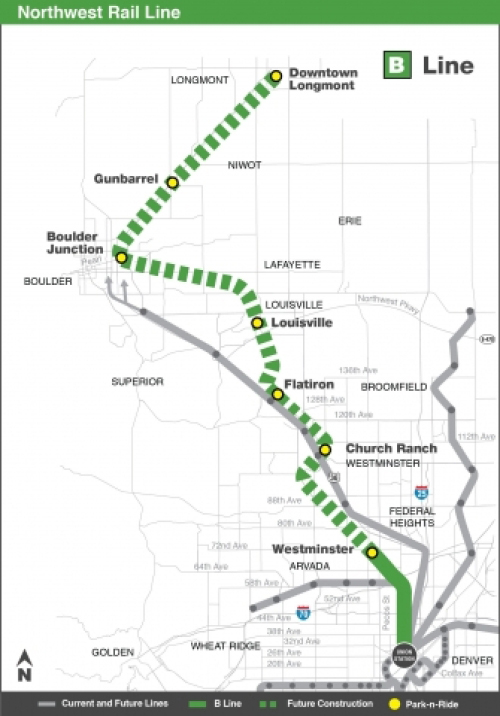
DENVER — The Regional Transportation District has hired a consultant to study the feasibility of a “peak service” plan to bring rail operations to its long-delayed Northwest, or B, commuter rail line.
The agency announced Wednesday that it had selected HDR Engineering Inc. to look into the possibility of offering three inbound morning trips and three outbound evening trips between Longmont, Colo., and Denver via Boulder. A commuter line to Longmont was approved as part of the 2004 FasTracks voter initiative, but only a short segment to Westminster has been built, and current estimates are that it would cost $1.5 billion and could take until 2050 to fully build out the remaining 35.3 miles of the B Line.
The study, expected to take two years, will provide updated engineering and cost estimates for the peak-service proposal, and will position the project for additional federal funding.
RTD CEO Debra Johnson said in a press release that the study “will provide RTD with public input and 2022 data that will enable the agency and interested parties to utilize a common set of facts in determining how best to serve the northern suburbs within the District. … I anticipate that the collective efforts with HDR Engineering will advance the path forward in a meaningful way.”
Johnson set off a controversy shortly after arriving at the RTD by questioning whether a rail line was the best way to serve Longmont [see “Digest: Denver RTD CEO questions plans …,” Trains News Wire, Jan. 14, 2021]. That led to criticism from Colorado Gov. Jared Polis and threats of legal action from Longmont, which has been helping fund the RTD since the 2004 initiative [see “Digest: Longmont, Colo, council to consider legal options …,” News Wire, Feb. 22, 2021]. Johnson eventually promised to revive plans for the line to Longmont, and the RTD approved funding for the feasibility study last August.













I am curious if anyone has kept track of how many consultants and how much money has been spent on them over the history of the Denver projects?
The single most promising heavy (conventional) rail route on the RTD system should be Denver to Boulder. US 36–the former Denver-Boulder Turnpike is a parking lot most of the day. This project exploded in cost because, as a part of the electric system of the RTD, it was over-engineered and thus seemed too costly to proceed. But as a diesel route it’s an entirely other matter.
The line would be ideal for DMUs, but even the sort of token rush-hour only service the RTD is considering would help. But it should not take two years to do a study on three round-trips.
As to the infrastructure on the Colorado and Southern line, it is indeed single track, but freight volume is way down with the decline of coal and in any event the right of way is more than wide enough to permit extended sections of second track to be included. The cost of this work–if not exploded by unneeded full electrification, will be a fraction any further potential widening of US 36. Moreover once ridership grows of course the catenary can be installed for fully electric operation.
Hybrid electric/diesel engines or multi-modal DM/EMUs could already power the trains as far as the Westminster stop, where present electrified service ends under a highway bridge by a meadow. Diesel usage would begin there with no change of trains.
The voters in Boulder County voted for proper rail service with Fast Tracks. The RTD’s constant stalling on this matter is a disgrace and has not gone unnoticed. I’d like to be optimistic that the service outlined here will be implemented–but this is already a spade-ready project for three round-trips per day!
I do not trust the RTD management in this matter. Indeed with the Biden BIL infrastructure funding the full implementation of the line as originally planned should now be well within reach. Indeed it could be incorporated into the Front Range Amtrak project as well.
Any RTD line from Denver to Longmont is going to require its own rail, not sharing the BNSF track. I don’t know how wide the BNSF right of way is along this route, but I know that BNSF runs double stacks along the line. Seeing that RTD runs EMUs powered by overhead catenary I don’t see how that could run on the existing trackage. Double stacks and catenary do not play nicely together.
It’s not even “new” construction, it will utilize the existing BNSF North-South line.
Throwing good money after bad.
This is a political stall to defer the noise over collecting the tax revenue from the voters who agreed to it but have nothing to show for it. It will be another 10 years before they act on the consultants report.
Over 25 years to build 35 miles of rail line?????????????? At that rate there still wouldn’t have been a transcontinental railroad.
All the time and money for three inbound AM trains and three outbound PM trains?